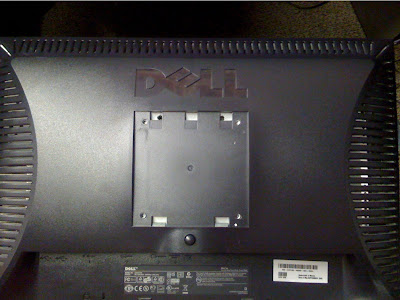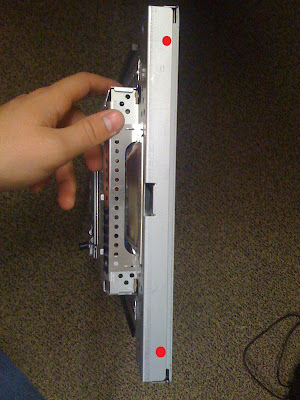1. Unplug the power and DVI or GA cable from the monitor
2. Detach the monitor stand. To do this, place the monitor face down on a flat surface and press (and hold) the button on the back right in the middle. Lift up on the stand and it should come right out. The picture below shows the position of the button, with the stand pushed to the left
4. Flip the monitor onto its back
5. Now the tricky part. You need to pry the faceplate off the rest of the case. This was the most difficult part since the faceplate is on there pretty tightly. I put the monitor on my lap, and started at the bottom middle, placing my fingers on the inside while trying not to press on the screen too much. Be careful around the buttons, as there is a circuit board attached by a ribbon to the rest of the hardware
If you look at the crack between the back of the case and the faceplate, you'll see a couple of slots. They're meant for a screwdriver or some other tool to help you pop the faceplate off. A combination of a tool and your fingers should make it easier for you to remove the faceplate without damaging it.
6. Ok, with the faceplate detached, now you need to get the circuit board off of the faceplate. I used a small straight screwdriver to pry up on it carefully. It's glued to the rubber buttons, but wasn't that difficult to get off. Once you have it detached, you can place the faceplate off to the side since you won't need it until you're ready to reassemble
7. Flip the monitor face down again, being careful with the circuit board and ribbon from the faceplate, and also making sure the screen doesn't fall out. The screen should be easy to remove from the backplate since it's really just sitting in there at this point without any screws or glue. Once it is out, take the stand button and spring off so you don't lose them later on. They're on the back
8. Remove the circuit board that is dangling now. To do so, just lift up on the brown flip clip that the ribbon cable is attached to. Once the clip is up, the ribbon cable should slide out easily
9. To remove the screen from the electronics, remove the four screws holding the screen to the cage you now have. There are two screws on each side. Be careful because there are also cables to disconnect before you can actually separate these two parts
10. Remove the cables connecting the electronics cage from the screen. To do this, first remove the four cables attached on the right side (assuming it's facing down, with the top of the screen furthest from you). They are underneath the thin, aluminum cover that can be removed just by lifting it off. The cables can be pulled out, carefully of course. If needed, use a small straight screwdriver to nudge them along on the sides to start, but they aren't being held in place by any clips so no need to worry about that
11. Remove the other cable attached to the monitor now. This is not attached with a clip either, but a small screwdriver should be used to gently get it started. I suggest removing the side that is on the electronics cage, and leaving the cable attached to the monitor. Once you have the cable out, set the screen aside until you're ready to reassemble
12. Now you have the cage, with the main board and power unit still attached. Time to remove the power unit. Remove the 4 screws in the corners, and also the two silver screws holding the actual power cord receptacle in place. Once those 6 screws are removed you can pull the power unit out, being careful as there are more cords attached underneath
13. There is a ground cable, and another ribbon cable. The ground cable can just be unscrewed from the cage. The ribbon cable is attached with a clip. Using a small straight screwdriver, carefully lift up on the clip while gently pulling back on the cable on the side attached to the power unit. You may need to do this on each side until the clip has gotten behind the latch part, after which you can finish removing the cable. Place the power unit off to the side until you're ready to reassemble
14. Now you just have the cage and the mainboard. There are four screws in the corners holding the mainboard in place, and a ribbon cable. There may also be two additional screws attached to the enclosure, and I've marked those two with a question mark. Unscrew the screws, gently remove the ribbon cable from the right side, then pull out the mainboard
15. That's it, and you have a Dell 2005FPW fully disassembled.
The reason that I ended up doing this is because I had two Dell 2005FPW monitors "die" in the same month. One went into a kind of strobe mode, constantly flickering and making it unusable. The other seemed to have problems staying powered on. I took the two apart to try to make one working monitor, but didn't have any luck. Still, taking things apart can be fun anyway.
I also just found this post, which also gives some directions and was originally designed to tell you how to fix backlight bleed by just using some electrical tape around the edges of your screen. Check it out if you're interested. From the responses, it sounds like this is actually a pretty successful fix.
























